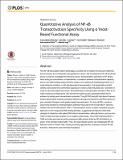Quantitative Analysis of NF-κB Transactivation Specificity Using a Yeast-Based Functional Assay
Author(s)
Sharma, Vasundhara; Jordan, Jennifer J.; Ciribilli, Yari; Resnick, Michael A.; Bisio, Alessandra; Inga, Alberto; ... Show more Show less
DownloadSharma-2015-Quantitative analysi.pdf (2.448Mb)
PUBLISHER_CC
Publisher with Creative Commons License
Creative Commons Attribution
Terms of use
Metadata
Show full item recordAbstract
The NF-κB transcription factor family plays a central role in innate immunity and inflammation processes and is frequently dysregulated in cancer. We developed an NF-κB functional assay in yeast to investigate the following issues: transactivation specificity of NF-κB proteins acting as homodimers or heterodimers; correlation between transactivation capacity and in vitro DNA binding measurements; impact of co-expressed interacting proteins or of small molecule inhibitors on NF-κB-dependent transactivation. Full-length p65 and p50 cDNAs were cloned into centromeric expression vectors under inducible GAL1 promoter in order to vary their expression levels. Since p50 lacks a transactivation domain (TAD), a chimeric construct containing the TAD derived from p65 was also generated (p50TAD) to address its binding and transactivation potential. The p50TAD and p65 had distinct transactivation specificities towards seventeen different κB response elements (κB-REs) where single nucleotide changes could greatly impact transactivation. For four κB-REs, results in yeast were predictive of transactivation potential measured in the human MCF7 cell lines treated with the NF-κB activator TNFα. Transactivation results in yeast correlated only partially with in vitro measured DNA binding affinities, suggesting that features other than strength of interaction with naked DNA affect transactivation, although factors such as chromatin context are kept constant in our isogenic yeast assay. The small molecules BAY11-7082 and ethyl-pyruvate as well as expressed IkBα protein acted as NF-κB inhibitors in yeast, more strongly towards p65. Thus, the yeast-based system can recapitulate NF-κB features found in human cells, thereby providing opportunities to address various NF-κB functions, interactions and chemical modulators.
Date issued
2015-07Department
Massachusetts Institute of Technology. Department of Biological EngineeringJournal
PLOS ONE
Publisher
Public Library of Science
Citation
Sharma, Vasundhara, Jennifer J. Jordan, Yari Ciribilli, Michael A. Resnick, Alessandra Bisio, and Alberto Inga. “Quantitative Analysis of NF-κB Transactivation Specificity Using a Yeast-Based Functional Assay.” Edited by Sue Cotterill. PLOS ONE 10, no. 7 (July 6, 2015): e0130170.
Version: Final published version
ISSN
1932-6203